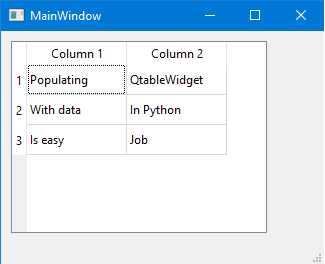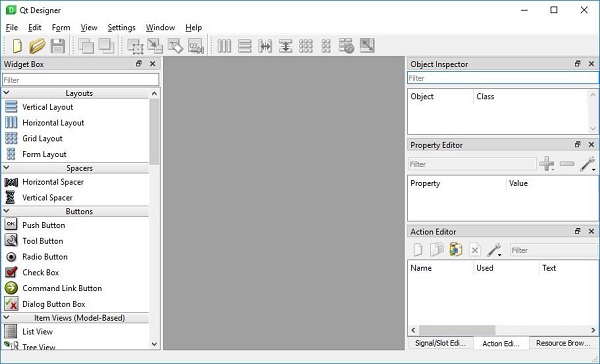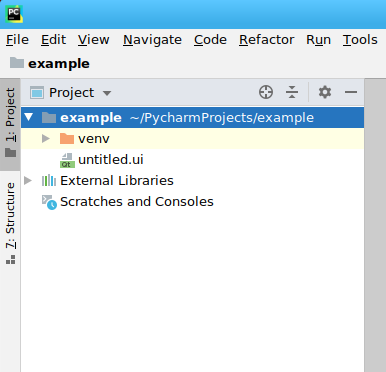

- #INSTALL PYQT5 WIDGETS HOW TO#
- #INSTALL PYQT5 WIDGETS SOFTWARE#
- #INSTALL PYQT5 WIDGETS CODE#
- #INSTALL PYQT5 WIDGETS DOWNLOAD#
The QWebEnginePage provides an object to view and edit web documents. The page function returns a reference to a web page object.
#INSTALL PYQT5 WIDGETS DOWNLOAD#
PyQt download link, PyQt SourceForge Project, Ĥ. QWebEngineView is the main widget component of the Qt WebEngine web browsing module. Integrating a Custom Widget into Qt Designer, ICS blog post, ģ. (Thanks go to my ICS colleague Kirill Bukaev for developing this demonstration code.) Referencesġ. Once you've done that, you can use Qt Designer to preview any widgets that you develop in Python with PyQt and see how they will appear in your application. Most of the effort to get this demonstration working involves building SIP and PyQt. we can preview the form and the UI controls can toggle the LED state, flashing mode, and flash rate in the preview window: In the screen shot below you can see the Qt Designer form showing some LED widgets. On Ubuntu these are in the package libpython3.4-dev, which you can install by running You will want to have the Python development tools installed.
#INSTALL PYQT5 WIDGETS HOW TO#
Moreover, we will see how to plot various GUI elements like buttons, windows, and input dialogs. In this PyQt5 tutorial of Python, we will learn a Python binding of Qt, which is a cross-platform GUI toolkit.

I will assume you already have installed Python 3 and some version of Qt 5. Today, we will explore Python PyQt5 Tutorial.
#INSTALL PYQT5 WIDGETS CODE#
Instead, we'll build the necessary code from source so that it can work with a version of Qt you may have compiled yourself. I didn't spend further time on it as I generally build Qt myself from source so that I can use a more recent Qt release than that provided by the Linux distribution. In my case (Ubuntu 14.04.5) it did not work for me.
#INSTALL PYQT5 WIDGETS SOFTWARE#
Since most Linux distributions include Qt and PyQt, you may be able to run the example code using the software packages provided by your Linux distribution rather than building it yourself. I used a recent version of Ubuntu Linux, but the steps should be the same on other distributions. I'll go over the steps needed to make this example work on a Linux desktop system. We will need to build this plugin as one of the steps to run the example code. That is not part of standard Qt itself, but rather part of PyQt, specifically a shared library libpyqt5.so. The key to using a PyQt widget from Qt Designer is a Qt Designer plugin to support PyQt widgets. LedGallery.ui: This is a Qt Designer UI file that has several LED widgets and some controls to adjust the state, flashing, and flash rate. Ledplugin.py: This implements a Designer plugin by subclassing the QPyDesignerCustomWidgetPlugin class and providing the required methods for a plugin. It is similar to the code in the C++ version. Ledwidget.py: A port of the earlier LED widget to Python and PyQt. Create beautiful app modern app interfaces using the custom widgets module. The download link (2) contains the example code referenced in this blog post. The QT-PyQt-PySide-Custom-Widgets Module was first released in June 2021 with the aim of helping QT Developers speed up the UI development process. Not all the steps to do this are obvious so I'll walk you through. tGeometry(self.left, self.top, self.width, self.In an earlier blog post (1) I described how to create a widget with a Qt Designer plugin interface so it can be viewed within Qt Designer. With the increased interest in using Qt from the Python programming language, I asked one of our developers to reproduce the same example, but implement the widget in Python with PyQt. Please Note that, The exec_() method has an underscore because exec is a Python keyword.įrom PyQt5.QtWidgets import QApplication, QWidget

Every PyQt5 application must create sys.argv application object which contains a list of arguments from the command line, and it is passed to the method while creating the application object.

The default constructor has no parent, and a widget with no parent is known as a window. It provides the default constructor for QWidget.It creates a new Window class that inherits from the base class, QWidget.QWidget is the base class of all user interface objects in PyQt5.


 0 kommentar(er)
0 kommentar(er)
